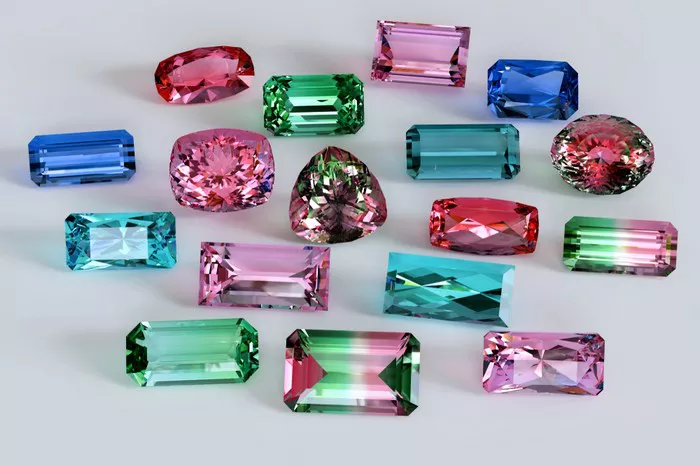Purple tourmaline, a captivating variety of the tourmaline group, is renowned for its stunning hues that range from delicate lavender to deep violet. This gemstone not only enchants with its color but also possesses a rich geological and cultural history that makes it a subject of interest for gemologists and collectors alike. In this article, we will explore the characteristics, formation, varieties, and significance of purple tourmaline, providing a comprehensive overview that is both informative and engaging.
What is Tourmaline?
Tourmaline is a complex boron silicate mineral that belongs to a group of related minerals characterized by their unique crystal structure. The name “tourmaline” is derived from the Sinhalese word “turmali,” which refers to a variety of gemstones found in Sri Lanka. This mineral group is notable for its wide range of colors, which can occur in a single crystal, often referred to as “watermelon tourmaline” when it exhibits pink and green hues.
Chemical Composition
The chemical formula for tourmaline is complex and varies depending on the specific type. However, the general formula can be represented as:
XY3Z6 BO3 3Si6O18 OH 4
In this formula:
X can be sodium (Na), calcium (Ca), or lithium (Li).
Y can be aluminum (Al), iron (Fe), magnesium (Mg), or manganese (Mn).
Z is typically boron (B).
The presence of different elements in the crystal structure leads to the wide variety of colors found in tourmaline.
Characteristics of Purple Tourmaline
Color
The most striking feature of purple tourmaline is its color. The purple hue is primarily due to the presence of manganese and iron in its composition. The intensity of the color can vary significantly, with some stones displaying a light lavender shade while others exhibit a deep, rich violet.
Clarity and Luster
Purple tourmaline typically has good clarity, although some specimens may contain inclusions. The luster of this gemstone is vitreous to resinous, contributing to its visual appeal. When cut and polished, purple tourmaline can exhibit a brilliance that rivals that of more traditional gemstones like amethyst.
Hardness and Durability
On the Mohs scale of mineral hardness, tourmaline ranks between 7 and 7.5, making it a durable choice for jewelry. Its toughness is further enhanced by its unique crystal structure, which helps resist chipping and breaking.
Formation and Occurrence
Geological Formation
Purple tourmaline forms in igneous and metamorphic rocks, particularly in areas with high boron concentrations. The mineral typically crystallizes in pegmatitic environments, where slow cooling allows for the growth of large crystals.
Notable Locations
Significant deposits of purple tourmaline have been found in various locations around the world, including:
Brazil: Known for its vibrant colors and high-quality crystals.
Afghanistan: Produces some of the finest purple tourmaline specimens.
California, USA: Notable for its historical significance in the tourmaline market.
Varieties of Purple Tourmaline
While purple tourmaline is a distinct variety, it can be classified into several types based on color, clarity, and origin.
Lavender Tourmaline
This lighter shade of purple is often referred to as lavender tourmaline. It is typically more affordable than its darker counterparts and is popular in fashion jewelry.
Deep Purple Tourmaline
Deep purple tourmaline, often more valuable, showcases a richer hue that is highly sought after by collectors. This variety is frequently used in high-end jewelry pieces.
See Also: Blue Tourmaline Benefits & Spiritual Properties
Cultural and Historical Significance
Historical Uses
Tourmaline has been cherished for centuries, with historical records indicating its use in jewelry dating back to ancient civilizations. In the past, it was believed to possess protective and healing properties, making it a popular choice among various cultures.
Modern Symbolism
In contemporary culture, purple tourmaline is often associated with creativity, emotional balance, and spiritual growth. It is believed to enhance intuition and promote a sense of calm, making it a favored stone among those interested in metaphysical practices.
Care and Maintenance
To maintain the beauty of purple tourmaline, proper care is essential. Here are some tips for cleaning and storing this gemstone:
Cleaning
Use warm, soapy water and a soft brush to clean purple tourmaline.
Avoid harsh chemicals and ultrasonic cleaners, as they can damage the stone.
Storage
Store purple tourmaline separately from other gemstones to prevent scratching.
Keep it in a soft pouch or lined jewelry box to protect it from damage.
Conclusion
Purple tourmaline is a gemstone that captivates with its beauty and complexity. Its unique color, durability, and rich history make it a prized possession for gem enthusiasts and collectors. As we continue to explore the world of gemstones, purple tourmaline stands out as a remarkable example of nature’s artistry, offering both aesthetic pleasure and cultural significance.
In summary, purple tourmaline is more than just a beautiful stone; it is a testament to the intricate processes of geological formation and the deep connections humans have forged with gemstones throughout history. Whether worn as jewelry or appreciated as a collector’s item, purple tourmaline remains a symbol of elegance and fascination in the world of gemology.


